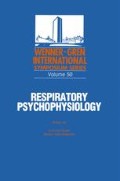Abstract
Breathing is controlled automatically (via chemo- and mechanoreceptors strategically located throughout the body) and can be voluntarily controlled as well. Volitional and automatic mechanisms can drive the respiratory muscles over separate anatomical pathways to the spinal motor neurons (Plum, 1970; Euler, 1986).
Preview
Unable to display preview. Download preview PDF.
References
Alpher, V.S., Nelson, R.B. III and Blanton, R.L. (1986). Effects of cognitive and psychomotor tasks on breath holding span. J. Appl. Physiol., 61, 1149–1152.
Altose, M.D. and Cherniack, N.S. (1980). Respiratory sensation and respiratory muscle activity. Adv. Physiol. Sci., 10, 111–119.
Altose, M.D., DiMarco, A.F., Gottfried, S.B. and Strohl, K.P. (1982). The sensation of respiratory muscle force. Am. Rev. Respir. Dis., 126, 807–811.
Altose, M.D., Cherniack, N.S. and Fishman, A.P. (1985). Respiratory sensations and dyspnea. J. Appl. Physiol., 58, 1051–1054.
Altose, M.D., Castele, R.J., Connors, A.F. and DiMarco, A.F. (1986). Effects of volume and frequency of mechanical ventilation on respiratory activity in humans. Respir. Physiol., 66, 171–180.
Altose, M.D., Mulholland, M.B. and Hudgel, D.W. (1986). Comparison of the intensity of breathlessness during exercise and voluntary hyperventilation. Fed. Proc., 45, 159.
Boiser, D.C., Lindsey, B.G. and Shannon, R. (1987). Medullary inspiratory activity: influence of intercostal tendon organs and muscle spindle endings. J. Appl. Physiol., 62, 1046–1056.
Borg, G.A.V. (1982). Psychophysical bases of perceived exertion. Med. Sci. Sports Exercise, 14, 377–381.
Campbell, E.J.M. and Howell, J.B.L. (1963). The sensation of breathlessness. Brit. Med. Bull., 19, 36–40.
Cherniack, N.S. (1986). Potential role of optimization in alveolar hypoventilation and respiratory instability. In Neurobiology of the Control of Breathing (eds. C. von Euler and H. Lagercrantz). Raven Press, New York, p. 45–50.
Chonan, T., Mulholland, M.B., Cherniack, N.S. and Altose, M.D. (1987). Effects of constraining thoracic displacement and changes in chemical drive on the sensation of dyspnea. J. Appl. Physiol. (in press).
Chonan, T., Mulholland, M.B., Leitner, J., Altose, M.D. and Cherniack, N.S. (1987). Comparisons of the sensation of dyspnea during hypercapnia, exercise and voluntary hyperventilation. Am. Rev. Respir. Dis., 135, A297.
El-Manshawi, A., Killian, K.J., Summers, E. and Jones, N.L. (1986). Breathlessness during exercise with and without resistive loading. J. Appl. Physiol., 61, 896–905.
Euler, C. von (1986). Brainstem mechanisms for generation and control of the breathing pattern. In Handbook of Physiology, The Respiratory System, Vol. II (eds. N.S. Cherniack and J.G. Widdicombe). American Physiological Society, Bethesda, Maryland, p. 1–67.
Killian, K.J., Bucens, D.D. and Campbell, E.J.M. (1982). Effect of breathing patterns on the perceived magnitude of added loads to breathing. J. Appl. Physiol., 52, 578–584.
Killian, K.J. and Campbell, E.J.M. (1983). Dyspnea and exercise. Ann. Rev. Physiol., 45, 465–479.
Killian, K.J., Gandevia, S.C., Summers, E. and Campbell, E.J.M. (1984). Effect of increased lung volume on perception of breathlessness, effort and tension. J. Appl. Physiol., 57, 686–691.
McCloskey, D.I. (1978). Kinesthetic sensibility. Physiol. Rev., 58, 763–820.
Mead, J. (1960). Control of respiratory frequency. J. Appl. Physiol., 15, 325–336.
Muza, S.R., McDonald, S. and Zechman, F.W. (1984). Comparison of subject response to inspiratory and expiratory resistances. J. Appl. Physiol., 56, 404–410.
Otis, A.B., Fenn, W.O. and Rahn, H. (1950). Mechanics of breathing in man. J. Appl. Physiol., 2, 592–607.
Plum, F. (1970). Neurological integration of behavioral and metabolic control of breathing. In Breathing Hering-Breuer Centenary Symposium (ed. R. Porter). Churchill, London, p. 159–175.
Plum, F. (1974). Cerebral control of breathing. In Ventilatory and Phonatory Control Systems (ed. Wyke). Oxford Univ. Press, London, p. 208–217.
Poon, C.S. (1983). Optimal control of ventilation in hypoxia, hypercapnia and exercise. In Modelling and Control of Breathing (eds. B.J. Whipp and D.M. Wilberg). Elsevier, New York, p. 189–196.
Poon, C.S. and Greene, J.G. (1985). Control of exercise hyperpnea during hypercapnia in humans. J. Appl. Physiol., 59, 792–797.
Shannon, R., Boiser, D.C., and Lindsey, B.C. (1987). Medullary expiratory activity: influence of intercostal tendon organs and muscle spindle endings. J. Appl. Physiol., 62, 1057–1062.
Sorli, J., Grassino, A., Lorange, G. and Milic-Emili, J. (1978). Control of breathing in patients with chronic obstructive lung disease. Clin. Sci. Mol. Med., 54, 295–304.
Stevens, S.S. (1957). On the psychophysical law. Psychol. Rev., 64, 153–181.
Stubbing, D.C., Ramsdale, E., Killian, K.J. and Campbell, E.J.M. (1983). Psychophysics of inspiratory muscle force. J. Appl. Physiol., 54, 1216–1221.
Supinski, G.S., Clary, S., Bark, H., Altose, M.D. and Kelsen, S.C. (1985). Effect of inspiratory muscle fatigue on the sense of effort during loaded breathing. Fed. Proc., 44, A5503.
Tack, M., Altose, M.D. and Cherniack, N.S. (1983). Effects of aging on sensation of respiratory force and displacement. J. Appl. Physiol., 55, 1433–1440.
Tenney, S.M. and Ou, L.C. (1977). Ventilatory response of decorticate and decerebrate rats to hypoxia and CO2. Respir. Physiol., 29, 81–92.
Editor information
Editors and Affiliations
Copyright information
© 1988 The Wenner-Gren Center
About this chapter
Cite this chapter
Cherniack, N.S., Chonan, T., Altose, M.D. (1988). Respiratory Sensations and the Voluntary Control of Breathing. In: von Euler, C., Katz-Salamon, M. (eds) Respiratory Psychophysiology. Wenner-Gren Center International Symposium Series. Palgrave, London. https://doi.org/10.1007/978-1-349-10461-1_5
Download citation
DOI: https://doi.org/10.1007/978-1-349-10461-1_5
Publisher Name: Palgrave, London
Print ISBN: 978-1-349-10463-5
Online ISBN: 978-1-349-10461-1
eBook Packages: Biomedical and Life SciencesBiomedical and Life Sciences (R0)

